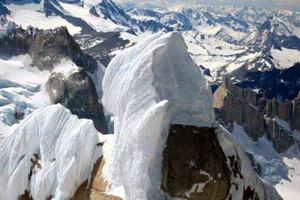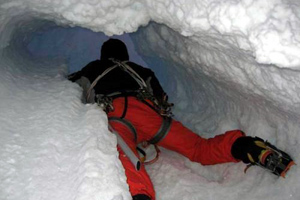
The summit of Cerro Standhardt viewed from Punta Herron. Standhardt marks the northernmost peak of the “the ultimate uberproject,” a traverse connecting these two peaks with those lying just south, Cerro Egger and Cerro Torre, Argentine Patagonia. From November 21-23, two separate teams–one comprised of Patagonia veteran Rolando Garibotti and Hans Johnstone, the other of four strong Italians: Ermanno Salvaterra, Alessandro Beltrami, Mirko Mase and Fabio Salvadei–covered more ground on the traverse than any other team, but a full enchainment still awaits. [Photo] Courtesy of www.intotherocks.net
From November 21-23, two teams–one comprised of Patagonia veteran Rolando Garibotti and Hans Johnstone (Issue 21’s “Local Hero”), the other of four strong Italians: Ermanno Salvaterra, Alessandro Beltrami, Mirko Mase and Fabio Salvadei–completed the second and third ascents of a bold Patagonian traverse, from Cerro Standhardt to Punta Herron to Torre Egger. The aim of both teams was also to enchain the fourth, taller peak, Cerro Torre. Connecting the four peaks has never been done and is regarded as “the ultimate uberproject…. Few lines anywhere are as aesthetic, obvious and difficult as this traverse,” wrote Garibotti in Issue 4’s “Unclimbed.”

Salvaterra climbing one of the interesting snow formations on Cerro Standhardt. [Photo] Courtesy of www.intotherocks.net
The traverse works south-southeast along the massif, toward Cerro Torre. The Italian team climbed a single pitch descending via the long, controversial east face–familiar to Salvaterra and Beltrami from their first ascent of El Arca de los Vientos (ABO: VI 5.11 A1 90 degrees, 1200m) with Garibotti in 2005. Garibotti and Johnstone went higher, completing about half of El Arca before retreating late on November 23.
In 2005, Thomas Huber and Andi Schnarf climbed the three-peak traverse in a thirty-eight-hour roundtrip. The ascent marked Huber’s third attempt of the season to climb Egger from the north; the first, with Stefan Siegrist, ended with bad conditions atop Punta Herron, and the second, with Schnarf and Rok Zalokar, was nearly successful–warm weather having deterred them from Egger’s summit mushrooms. Salvaterra had attempted the traverse a number of times with Maurizio Giarolli and Elio Orlandi throughout the 1980s and 1990s.
Garibotti and Johnstone climbed Cerro Standhardt via Festerville (5.11), whereas the Italians climbed the west face to make the second ascent of Otra Vez (5.10 A1 80 degrees, Giarolli-Orlandi-Salvaterra, 1200m, 1989). It was Salvaterra’s fifth time and Beltrami’s third time summiting Standhardt. Both teams climbed Punta Herron via Spigolo di Bimbi (5.10 90 degrees, Calvallaro-Salvaterra-Vidi, 1991), and Torre Egger via its northwestern arete (5.10 and mixed). They rappelled to the Col of Conquest, from where the Italians descended the east face of Cerro Torre after one pitch and Garibotti and Johnstone continued upward.

Salvadei climbs through the final snow tunnel to the summit of Torre Egger. [Photo] Courtesy of www.intotherocks.net
Patagonia’s unpredictable weather, coupled with the instability of these summits, makes the four-peak traverse (ca. 2200m of vertical gain) a fickle objective comprehensible by only the best in perfect conditions. “Undoubtedly great imagination and courage will be required to put together all the pieces of this puzzle,” Garibotti said.